SUMMARY OF FINDINGS
SUMMARY
Nearly two-thirds (66% or 10.5 million people) of the Australian population aged 15 years and over reported that they had participated in sports and physical recreation at least once during the 12 months prior to interview in 2005-06. Similar proportions of males and females (both 66%) participated at least once during this period. Participation in activities organised by a club, association or other organisation also showed similar proportions for males (2.3 million or 29%) and females (2.1 million or 26%).
Almost one in three (29% or 4.7 million people) of the population aged 15 years and over participated in sports and physical recreation activities twice per week. More females (32% or 2.6 million) than males (27% or 2.1 million) were involved in more than twice-weekly participation.
The number participating in non-organised activities (8.6 million or 54%) was almost double that for participation in organised activities (4.4 million or 28%).
Walking was the most commonly reported physical recreation activity for both males and females, with 4.0 million people (25%) participating. This was followed by aerobics/fitness (2.0 million or 13%), swimming (1.4 million or 9%) and cycling (1.0 million or 6%).
AGE AND SEX
The highest participation rates were reported by people aged 25-34 years (75%) and 15-17 years (75%) and the lowest for those aged 65 years and over (49%).
Overall, males (5.2 million or 66%) and females (5.3 million or 66%) showed similar participation rates for sports and physical recreation activities in the 12 months prior to interview.
PARTICIPANTS, Sports and physical recreation - By age and sex
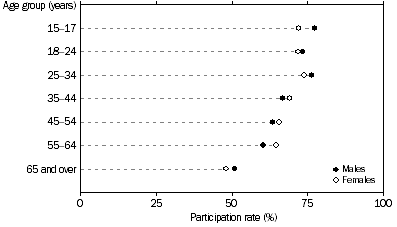
AREA OF RESIDENCE
The highest participation rates were reported for the Australian Capital Territory (80%) and Western Australia (71%), while those living in the Northern Territory had the lowest rate of participation (58%). More people living in state capital cities participated at least once in a sport or physical recreation activity than residents living in the two territories and elsewhere in Australia (6.7 million and 3.9 million respectively).
PARTICIPANTS, Sports and physical recreation - By state or territory and sex
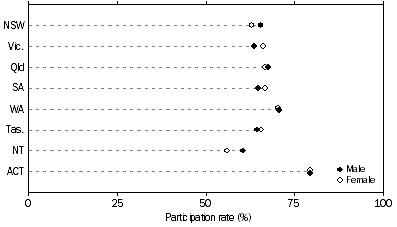
BIRTHPLACE
People born overseas in main English speaking countries had the highest rate of participation (72%). This was higher than the participation rate of those born in Australia (68%) and those born in other countries (52%). Females born overseas in main English speaking countries had the highest participation rate (73%) while females born in other countries had the lowest rate of participation (48%).
EMPLOYMENT STATUS
Employed people had a higher participation rate (72%) than those who were unemployed (66%) or those who were not in the labour force (55%). Respondents who were not in the labour force had the lowest rate of participation in sports and physical recreation during the 12-month period prior to interview (55%).
HOUSEHOLD COMPOSITION
The highest participation rate was reported by members of group households (75%), followed by those in couple families with dependent children (70%) and couple only households (68%). Those living in multiple family households with dependent children had the lowest participation rate (41%). People living in lone person households had a relatively lower rate of participation (60%).
TYPE OF PARTICIPATION
An estimated 4.4 million Australians aged 15 years and over participated in some sports and physical recreation organised by a club, association or other organisation during the 12 months prior to interview. These accounted for 42% of participants and a participation rate in organised activities of 28%. Over half (55%) of those aged 15-17 years participated in organised activities, declining to 41% and 33% for those aged 18-24 and 25-34 years respectively. Of those aged 65 years and over, 18% participated in organised physical recreation of some kind.
Over 8.6 million or 54% of people aged 15 years and over participated in non-organised sports and physical recreation. Males and females had a similar rate of participation (53% and 54% respectively) in non-organised activities. The rate of participation was also similar for most age groups.
FREQUENCY OF PARTICIPATION
About a third (32% or 5.1 million) of the population aged 15 years and over undertook sports or physical recreation activities for a total of 105 times or more in the previous twelve months. More females (2.8 million) than males (2.3 million) participated for 105 times or more with the rates of participation at this frequency being 30% and 34% respectively.
The majority of participants (56% or 6.0 million) undertook just one activity, with 25% participating in two activities, and 18% in three or more activities. Males and females participated in similar numbers of activities.
REGULARITY OF PARTICIPATION
Regular participation in sports and physical recreation activities was defined as participation undertaken more than twice a week in the 12 months prior to interview. The survey found there were 4.7 million people (29% of the population) who regularly participated in sports and physical recreation activities. This represented almost half (45%) of all participants.
Occasional and infrequent participants numbered 3.7 million and represented over a third (35%) of participants (23% of the population aged 15 years and over). Infrequent, part-year participation was a feature of those in the younger age groups, with 16% of those aged 15-17 and 12% of those aged 18-24 and 25-34 years reporting this level of participation.
PARTICIPANTS, Sports and physical recreation - Regularity of participation
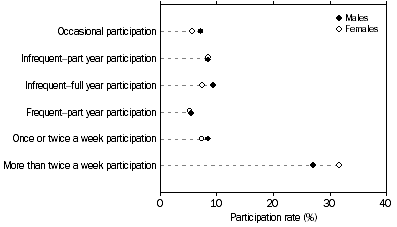
More females (32% or 2.6 million) participated more than twice a week than males (27% or 2.1 million). Females aged 25 to 64 years, reported similar rates of more than twice-weekly participation (ranging from 33% to 37% across the age groups) while males aged 15-17 years were more likely (33%) to participate twice-weekly than males in other age groups.
MAIN SPORTS AND PHYSICAL RECREATION ACTIVITIES
Among Australians aged 15 years and over, walking was the most commonly reported physical recreation activity, with over 4.0 million people participating in the 12-month period prior to interview. The overall participation rate for walking was 25%. The next most popular activities were aerobics/fitness (2.0 million participants and a participation rate of 13%), swimming (1.4 million or 9%) then cycling (1.0 million or 6%). Participation in golf attracted 6% of the population aged 15 years and over (875,500) during the 12-month period, followed by both tennis (768,900 or 5%) and running (681,300 or 4%). Participation in outdoor soccer (419,600 or 3%) was higher than Australian Rules football (268,700 or 2%).
Twice as many females as males (2.7 million and 1.3 million respectively) walked for exercise in the 12-month period. More males participated in Australian Rules football (240,800) than females (27,900) and males also dominated in soccer (indoor and outdoor) (459,600 compared to 155,600 females), cricket (indoor and outdoor) (424,700 compared to 30,800 females) and fishing (220,100 compared to 30,800 females). By comparison, female participation in netball (387,500), yoga (248,700) and dancing (177,300) was higher than that of males (43,400, 24,800 and 47,700 respectively).
Of all the sports and physical recreation undertaken in an organised capacity, the activity most commonly participated in by Australians 15 years and over, was aerobics/fitness (570,000). Netball (333,800) was the next most popular organised sport followed by tennis (250,400) and soccer (outdoor) (248,500). Activities that were commonly undertaken only in a non-organised capacity were walking for exercise (3.9 million), aerobics/fitness and swimming (both 1.3 million) and cycling (913,100). Activities that were commonly undertaken both in an organised and a non-organised capacity included golf (175,000), aerobics/fitness (160,600) and swimming (99,300).
PARTICIPANTS, By top ten sports and physical recreation activities and sex
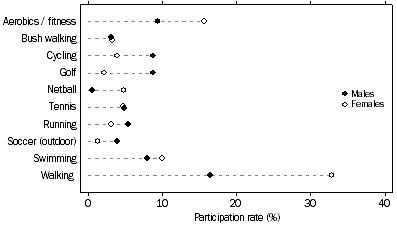
The 'main sports and physical recreation activities' presented below are the ten activities with the highest participation rates reported by Australians aged 15 years and over, in the 12 months prior to the survey.
Aerobics/Fitness
There were an estimated 2.0 million Australians aged 15 years and over who reported that they had participated in aerobics/fitness activities in the 12 months prior to interview. This activity was the second most popular after walking, with a participation rate of 13%.
Females had a higher rate of participation in this activity (16%) compared to males (9%). Those aged 18-24 years had the overall highest participation rate (20%).
Residents of the Australian Capital Territory (18%) reported the highest participation rate for this activity.
The majority of people (64%) who were involved in aerobic/fitness activities participated in a non-organised capacity only. This is more than double the rate for those who participated in aerobic/fitness activities organised by a club, association or other organisation (28%).
Of the estimated 2.0 million people who participated in aerobics/fitness activities during the 12-month period, the majority (74%) participated 53 times or more in the 12 months. A further 12% participated between 27 to 52 times while 8% had done so 13 to 26 times, and 7% for 1 to 12 times.
Bushwalking
In the 12-month period prior to interview, there were more than half a million Australians aged 15 years and over who reported that they had been bushwalking. The overall participation rate was 3%, with males and females showing similar rates of participation (both 3%).
Tasmania had the highest participation rate for bushwalking (6%) while New South Wales had the highest number of people aged 15 years and over participating in this activity (195,400).
The 45-54 year age group had the highest number of people participating in bushwalking (144,300). The rates of participation were similar for those aged 45-54 years, 35-44 years and 55-64 years (5%, 4% and 4% respectively).
Of all bushwalkers, 87% participated on a non-organised basis only, whereas only 7% of bushwalkers participated solely in organised bushwalking.
There were 341,400 bushwalkers (66%) who went bushwalking 53 times or more in the 12 months prior to interview, with a further 78,100 people (15%) participating 27 to 52 times, 56,800 people (11%) participating 1 to 12 times and 43,200 people (8%) bushwalking 13 to 26 times.
Cycling
There were over 1.0 million (6%) people aged 15 years and over who had been cycling in the 12 months prior to interview, with more than twice as many males (9% or 691,000) reporting having cycled than females (4% or 320,700).
The Australian Capital Territory recorded the highest participation rate for cycling (12%), with New South Wales and Victoria recording the highest numbers (298,300 and 256,100 respectively).
The highest number of people (281,500) who went cycling were aged 35-44 years.
The majority of people who went cycling participated only in a non-organised capacity (90%), with only a very small number involved solely in organised cycling (2%).
More than three quarters (79%) of the estimated 1.0 million people who cycled participated in this activity for 53 times or more in the 12 months prior to interview. A further 12% undertook cycling from 27 to 52 times in the same period.
Golf
There were 875,500 or 6% of Australians aged 15 years and over who participated in golf in the 12 months prior to interview. Almost four times as many males (695,600) as females (179,900) played golf in the same period.
New South Wales and Victoria recorded the highest number of participants (277,000 and 236,900 respectively).
Those aged 55-64 years had the highest participation rate (9%) and the highest number of participants (190,100).
More than half (54%) of people who played golf in the 12 months prior to interview participated only in a non-organised capacity while 26% of golfers were involved only as participants through a club or association.
Of the 875,500 people aged 15 years or over who played golf, 61% (535,900) participated 53 times or more, 16% (137,000) for 27 to 52 times, 13% (117,700) for 1 to 12 times and 10% (85,000) for 13 to 26 times.
Netball
In the 12 months prior to interview, there were an estimated 431,000 Australians aged 15 years and over who played netball. This represented a participation rate of 3%. Netball was more popular among females, with over eight times as many females (387,500) participating than males (43,400).
Victoria and New South Wales had high numbers of participants aged 15 years and over (126,900 and 121,500 respectively).
The highest participation rate in netball was recorded by those aged 15-17 years (10%) with the highest number of participants being from the 25-34 year age group (127,300).
The majority (78%) of netball participants played netball organised by clubs, associations or other organisations, while 19% played only in a non-organised capacity.
Of the total number of people who played netball, 63% (270,500) had done so 53 times or more in the 12 months before interview. Almost a quarter of the participants (24% and 102,100 people) had participated for 27 to 52 times in the same period.
Running
There were an estimated 681,300 Australians aged 15 years and over who had reported that they participated in running as a sport or physical recreation activity in the 12 months prior to interview. The overall participation rate was 4%, with males having a higher participation rate than females (5% and 3% respectively).
The highest number of participants (244,500) was reported by New South Wales, followed by Victoria (171,000) and Queensland (122,800).
High numbers of participants were reported for the age groups 25-34 years (205,900) and those aged 35-44 years (168,100).
The majority of people (89%) who participated in running did so in a non-organised capacity.
Of all runners, 585,200 (86%) went running 53 times or more, while a further 53,600 (8%) participated 27 to 52 times.
Soccer (outdoor)
Soccer (outdoor) was the equal 9th (with netball) most popular sports and physical recreation activity among Australians aged 15 years and over (3% or 419,600). More males participated (4% or 311,500) than females (1% or 108,100).
The 15-17 year age group recorded the highest participation rate (16%) as well as the highest number of participants (127,500) in the 12 months prior to interview. The majority of the participants (59%) played outdoor soccer only in an organised capacity. Similarly, 65% played outdoor soccer 53 times or more in the 12 month period.
New South Wales recorded the highest number of participants (219,800) and the highest participation rate (4%). This was followed by Victoria (76,700) and Queensland (63,000), both with similar rates (2%).
Swimming
Swimming recorded the third highest participation rate (9%) of all sports and physical recreation activities among Australians aged 15 years and over in the 12-month period prior to interview. More females (10% or 814,000) than males (8% or 633,300) participated in this activity.
High rates of participation were recorded for those aged 25-34 years (12%), 35-44 years (11%) and 45-54 years (11%).
Rates of participation were similar for the Australian Capital Territory (11%), New South Wales and Western Australia (both 10%). New South Wales had the highest number of participants (556,400).
The majority of swimming participants (87%) participated in a non-organised capacity. More than three quarters of participants (77% or 1.1 million) went swimming 53 times or more in the 12 months prior to interview. A further 13% (186,300) of swimmers participated 27 to 52 times, and 6% or 89,500 participated 13 to 26 times.
Tennis
In the 12-month period prior to interview, 768,900 Australians aged 15 years and over reported playing tennis as a sport or physical recreation activity. This represents a participation rate of 5%. Males and females showed similar participation rates (both 5%).
New South Wales recorded a participation rate of 6% for tennis and the highest number of people who played tennis (309,000). South Australia and Victoria had similar participation rates (6% or 68,400 and 5% or 191,300 respectively).
People aged 15-17 years recorded the highest participation rate for tennis (9%), followed by those aged 25-34 years and 18-24 years (both 6%). The highest number of participants were from the 25-34 year age group (171,000), followed by the 35-44 year age group (147,700) and those aged 45-54 years (127,200).
Most tennis participants (59%) were involved in this activity only in a non-organised capacity. Approximately a third (33%) participated only on an organised basis.
Almost three quarters of participants (73% or 563,500) played tennis for 53 times or more in the 12-month period prior to interview. A further 13% (102,000) were involved for 27 to 52 times, 8% (57,300) for 1 to 12 times and 6% (46,000) for 13 to 26 times in the same period.
Walking
Walking was the most commonly reported sports and physical recreation activity among Australians aged 15 years and over, with a participation rate of 25%. Females had a higher participation rate (33%) than males (17%), with over twice as many females (2.7 million) than males (1.3 million) reporting walking for physical recreation or exercise in the 12 months prior to interview.
The Australian Capital Territory recorded the highest participation rate for walking (36%). This was followed by South Australia (28%), Western Australia (28%) and Tasmania (27%).
People aged 55-64 years reported the highest participation rates for walking (35%). The participation rates were similar for those aged 45-54 years (31%) and those aged 65 years and over (29%). The highest number of participants were from the 45-54 year age group (853,300).
Nearly all participants (98%) in this activity did so only in a non-organised capacity.
Most participants (82% or 3.2 million) walked for recreation 53 times or more over the 12-month period before interview. A further 10% (383,600) participated for 27 to 52 times and 5% (199,700) for 13 to 26 times.
CONSTRAINTS ON PARTICIPATION
Constraints on participation were asked of people who did not participate in sports and physical recreation activity or those who participated only for 1-12 times in all activities in the 12 months prior to interview. An estimated 1.7 million people indicated that insufficient time due to work or study was a common constraint to participation. This represented 23% of responses. Simply being 'not interested' in sport or physical activity was the second most common reason given (1.4 million or 19% of responses).
Among males, insufficient time due to work or study was the most common reason given (1.0 million or 28% of responses). Females, however, cited a number of reasons for not participating including being not interested (719,400 or 19% of responses), insufficient time due to work/study (698,200 or 19%) and age/too old (658,700 or 18%).
When asked for the main reason for non-participation, responses were similar. Some respondents also reported age (1.1 million or 17%), on-going injury or illness (920,900 or 14%) and insufficient time due to family responsibilities (606,700 or 10%) as their main reasons for non-participation.
More males (27%) than females (18%) reported insufficient time due to work or study as the main reason for not participating in sports or recreation activities. In comparison, more than twice the number of females than males (435,400 or 14% and 171,200 or 5% respectively) indicated insufficient time due to family commitments as being the main reason for their low level of participation.
Almost half (47%) of people aged 15-17 years who were asked about their participation indicated lack of interest as their main reason for not participating. Insufficient time due to work or study commitments was the main reason most commonly indicated by those aged 18-24 years, 25-34 years, 35-44 years and 45-50 years (40%, 31%, 31% and 27% respectively).
Age and on-going injury or illnesses were the main constraints cited by those aged 55-64 years and 65 years and over (44% and 75% respectively).
Non-participants and low level participants, Sports and physical recreation - By all constraints and sex
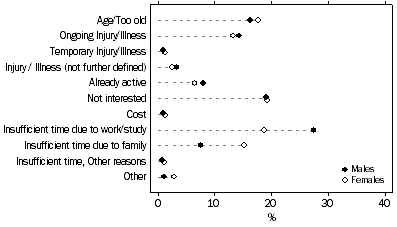
MOTIVATORS FOR PARTICIPATION
Those who participated in sports and physical recreation activities 13 times or more in the 12-month period prior to interview were asked their reasons for participation. A variety of reasons were reported including health and fitness (33% or 7.8 million people), enjoyment (21% or 5.2 million), well-being (16% or 3.9 million) and social or family reasons (14% or 3.2 million).
When asked about the main reason for participating, health/fitness and enjoyment dominated the reasons given by participants (54% and 22% respectively). More females than males indicated health, fitness and well-being as being important, whereas more males than females indicated enjoyment and social or family reasons as a reason for participating.
Enjoyment was the main reason for participating given by close to half (45%) of participants aged 15-17 years. This proportion declined to 30% for those aged 18-24 and was the main reason for about one in five of those in all other age groups. In contrast, health and fitness was the main motivator indicated by more than half of those in all age groups from 25-34 years to 65 years and over, but was the main reason for just one quarter (26%) of those aged 15-17 years.
Participants (for 13 times or more), Sports and physical recreation - By all motivators and sex
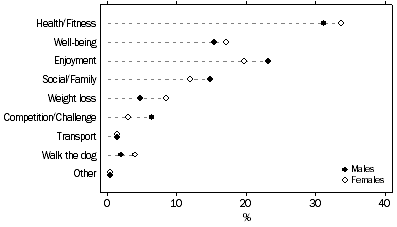
 Print Page
Print Page
 Print All
Print All